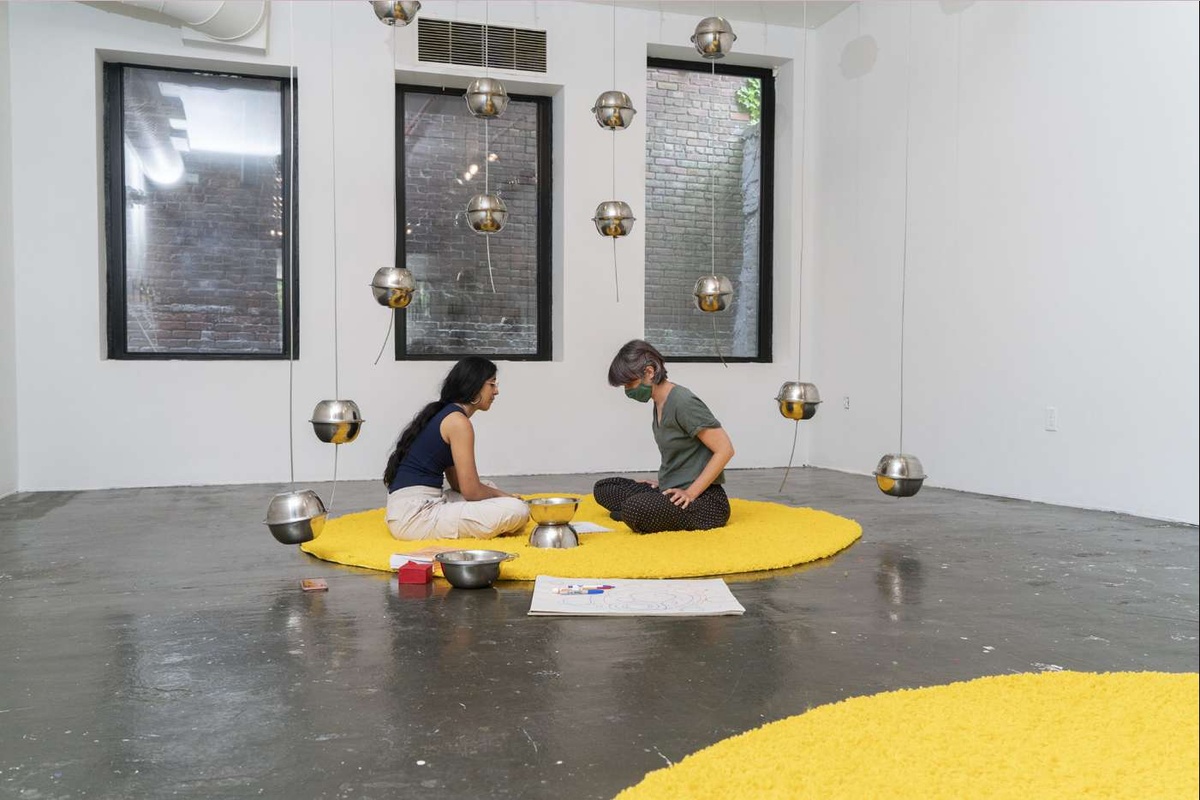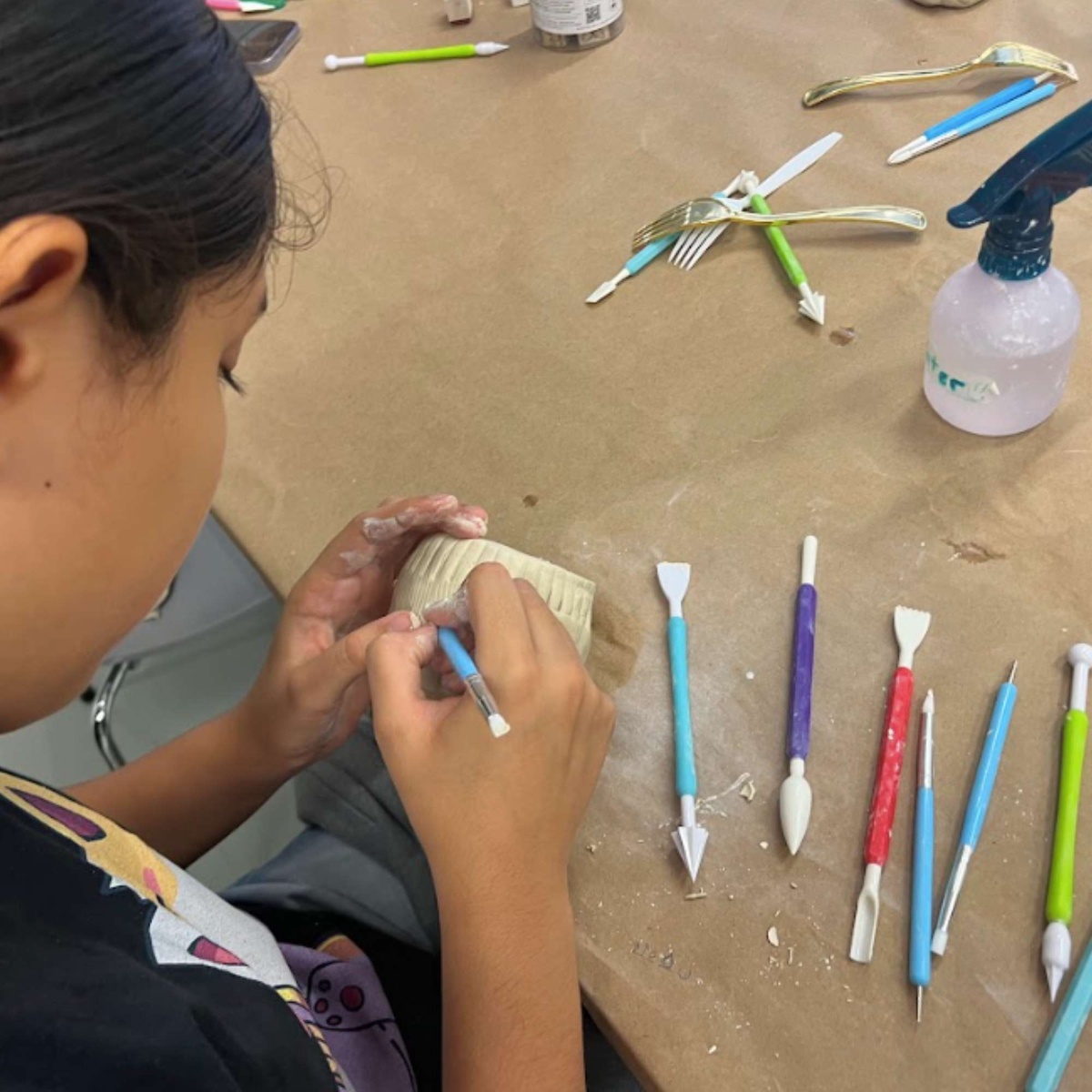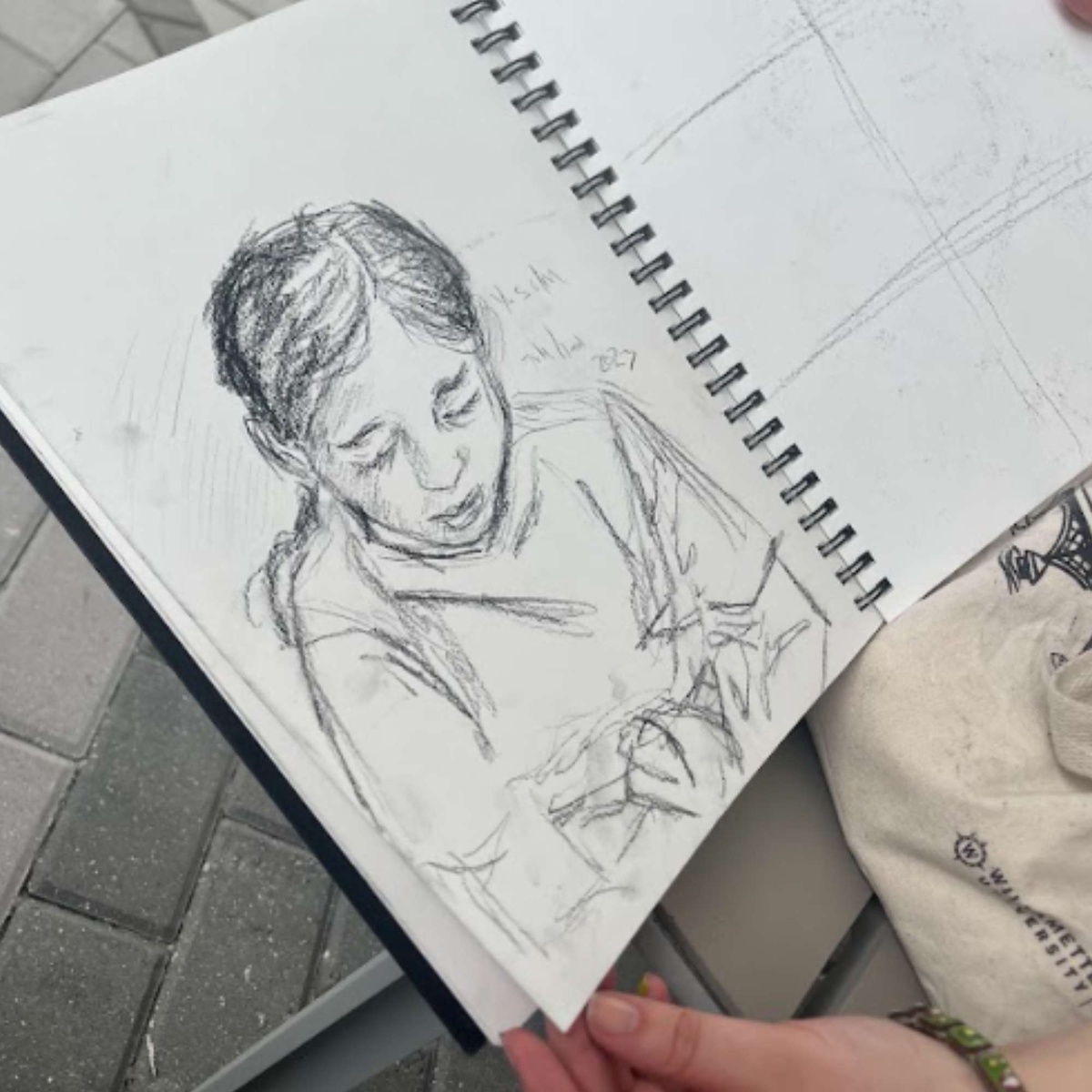Recess Reflection—Part 1 of 3
Artist & Session Alumni Smita Sen on care for caregivers, her new non-profit, and Recess's support.
Prerana Reddy: I’ve invited 2021 Session Artist Smita Sen to speak with me about her experience with Recess’s Care & Capacity Funds. First developed in the midst of the pandemic, the funds were intended to be a response to the isolation artists were feeling, both from the intended audience for their work, and from the social networks that might ordinarily provide a sounding board for their ideas. At the outset, it was literally about resourcing the creation of a “Care Circle” of people from the extended Recess community that would hopefully surround the artist with fellowship, emotional support, skillsharing, and/or mentorship. Over time, we tried to be more responsive to what artists articulated that they really needed to feel more capacitated emotionally and physically. At the same time, we aspired to provide some thought partnership for the artist to make sense of their Session experience and to deepen their continued practice. Smita, can you start by sharing how the Care Circle Funds were first presented to you and what you initially thought you’d do with them?
Smita Sen: When the Care Circle was presented to me, I was in the flurry of preparing for that initial install and all the other deliverables! I mostly understood it as an aftercare support system consisting of a sequence of conversations with Recess stakeholders to support an artist's growth beyond the project. So it was all of those things you described in terms of creating a support system, and also creating longevity and engagement across all of the Recess programs. And it was really nice. I feel like the original vision was very cool, but it was also confusing–there were so many options of what you could do! At first, I think An [An Duplan, Prerana’s predecessor at Recess] and I were just thinking about coming up with something fun, something celebratory, but soon we started thinking that it could be more of a long-term, more sustained conversation.
P.R. : Your project Manipura Sanctum was about considering care for caregivers. How did you feel that informed where you took the Care Circle funds and how you used it?
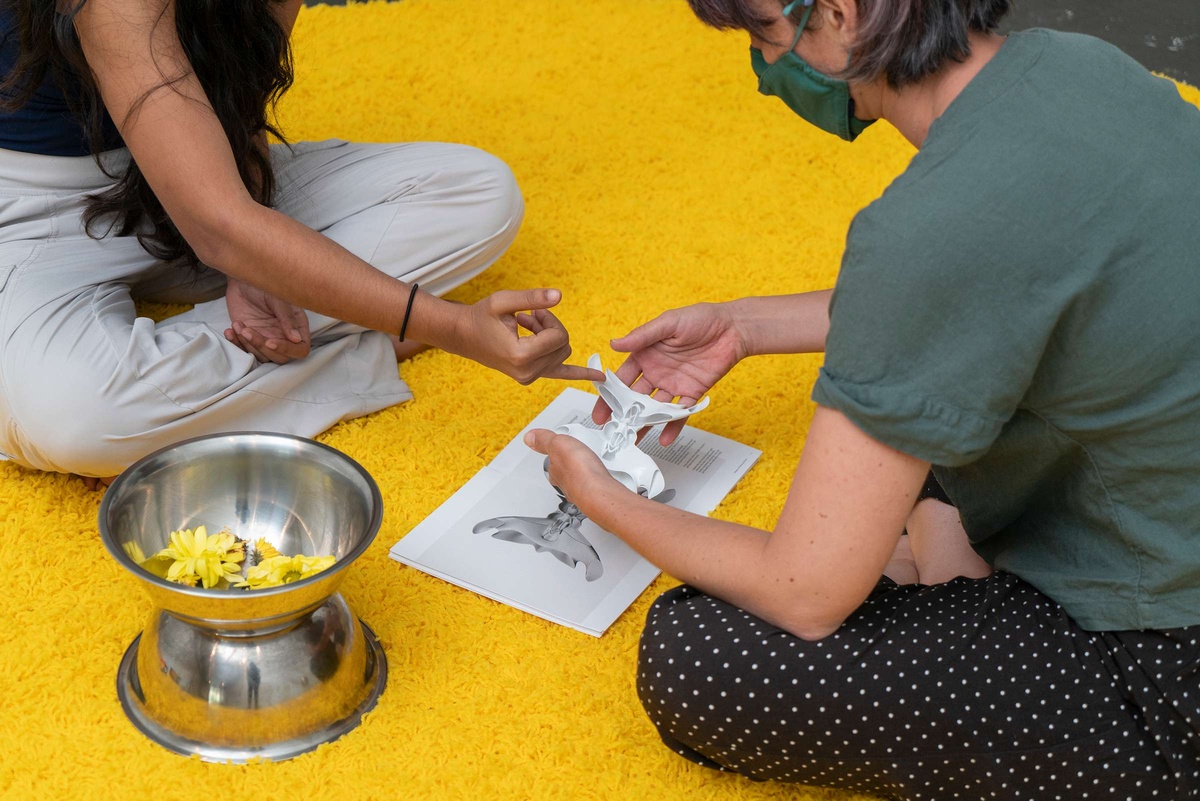

Smita sits with a visitor to her Session project. She gives them a 3D printed sculpture she's created to examine. Next to them on the rug is a book by Smita.
S.S. : For me, caregiving was really tied to moments of medical need and the healthcare system, but also the kind of community that arises around the kind of extreme interdependence that is required with illness. So when it came to the Care Circle and developing a larger project, I was invited to engage the wider community that my project is intended to serve. I feel like that was really useful and offered a lot of potential power to create impact. And that was the great gift of the Care Circle.
For me it was actually a very large amount of money in terms of startup funds for a new artistic endeavor, or a new kind of nonprofit endeavor. When I was at Recess in 2021, it was actually really difficult to get in touch with an active caregiving community, because people were really strained and stressed by the pandemic. Getting folks to the Session space itself was really hard, so being able to have the support of the Care Circle funds to go and meet folks where they're at afterwards was very helpful. What the funds allowed me to do, at least initially, was develop this initial research, figuring out the best way to reach the demographic that I wanted to serve.
And it gave me time to do that. I could go slow and make sense of how best to create the structure in order to serve this larger community. So going from the Manipura Sanctum installation to the Manipura Care Network nonprofit, we're now serving this demographic–youth caregivers, young people who care for a sick, elderly or disabled family member. They make up about 10% of the 50 million unpaid caregivers in the United States, and they also have zero protection because they're minors. They are not eligible for any kind of state or federal funding. They don't have any kind of major nonprofits serving them aside from the American Association of Caregiving Youth, which I partnered with to create avenues for educational access and to improve the quality of life for youth caregivers through the study and practice of the arts.
And so with the Care Circle, I was able to create the initial infrastructure that you need to start a nonprofit, like filing fees as well as setting up a website, setting up an official email, setting up the legitimacy needed to build partnerships, and to get basic liability insurance. And since funding often begets more funding—to have seed funding meant that we had a lot of legitimacy going into further conversations asking for donors to support the work we wanted to do. I think that so many people jump into service without actually understanding the people that they want to serve. The Care Circle really gave me a chance to understand the people that I wished to support.
The Care Circle is more than just money, there's an ethos to the way the funding is given to the artist, as well as the supportive conversations with the artists about how those funds should be used in a thoughtful way. At the very beginning I was like, why don't I just regrant this? And that was the wrong understanding. I think Recess actively pushed me away from that. I think that was you. That was our conversation. And I think that having that explicit language is also part of the way that my thinking around Care Circle evolved. So yeah, I think it made me a better person. I think it made the work smarter. I think it also ended up serving more people than we could have originally imagined.
P.R. : I still have many artists who want to give it away, but I try to get them to lean into the question of how do you build a community around your idea, or create the potential for longevity, if that’s desired. I think another reason why people want to give it away is maybe they don't feel like they're worthy. There's always someone who needs it more, or is more deserving than them. Even though the artists we work with at Recess are already creating multiple offerings for the public while in Session, maybe they don't see the cost of that giving, of that sharing with the public? Therefore, they don't see themselves as deserving of care. And I'm wondering for you, did that pause also allow you to ask yourself “How am I caring for myself?” Another intention of the program is giving people the opportunity to self-identify whether they also are in need of the money for whatever is stressing them out most, or for what they need to make their own lives more sustainable and resilient.
S.S. : Yeah, I think that the instinct is definitely like, oh, there's someone else or some cause that’s more deserving. These are the people that I'm serious about serving. Why not just put this cash directly in their hands? But I think that it's a really critical part of abolition as an approach, that while direct services are really important in immediate emergencies, long-term, sustained relationship-building needs to be structured differently. Addressing needs requires real dialogue and sustained engagement. It was really helpful to also see that I could care for myself in the sense that I could understand and deepen my relationship to this part of my identity that is not always acknowledged in my day-to-day life, which is that I also was a caregiver and not just any caregiver, a palliative caregiver.
If you have lived that, you can be a part of the caregiving community. If you can remain engaged with this community, then suddenly the funds mean something different. It's not just something to give away. It's also like, “Can I nourish this part of myself in conversation with all of these other people living and navigating the same challenges?” And it was really nice. I don't know if this is the best place for the money to go, but I think that there's something powerful about also honoring yourself in that dialogue.
P.R. : A lot of people just think of care as doing something nice for yourself or attending to your health. And that’s true, and definitely something artists can use Care Funds for because we're all deserving of a little bit of comfort and ease. But, I think that the original sense of nourishing your network–nourishing relationships–is emerging as another form of care that needs broader support. Often artists are really just thinking of the next residency or next exhibition and they don't take that time to really ask: “What's my trajectory and how do I want to grow? Who do I want to grow with or hear from in that development of growth?” Whether or not you're using the funds for a new project, to reflect on what you learned from Session, or to determine which future opportunities to pursue, Care & Capacity Funds can help you consider your trajectory more intentionally.
This transition from Care Circle to a Care and Capacity Fund allows for the fact that there are a lot of things that go into career building, relationship building, and understanding your audience like travel expenses, stipends, art storage, research materials, legal fees, etc., that may on the surface appear to be logistical expenses. But without them, those relationships couldn't happen or those meetings couldn't happen. And so we’ve tried to open up the Care Circle concept in a way to actually meet people where their real needs are.
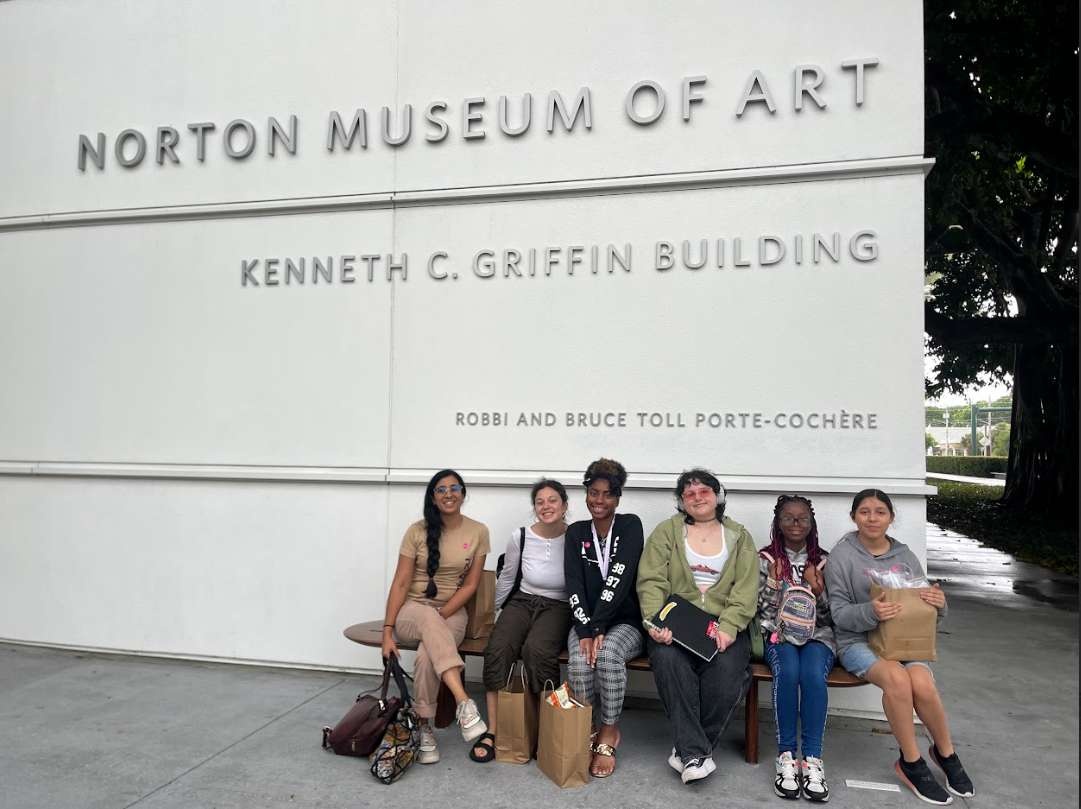

Smita and the Manipura Care Network fellows on a field trip to the Norton Museum of Art.
S.S. : Also it was meaningful for me to take this support in relation to the DEI focused dialogue that is so robust in New York City, and the abolition based dialogue that is so robust at Recess, and to take it to my hometown of Miami-Dade County in Florida, which at times can be a more conservative environment. It has been very special for me to be able to have the support to actually care for my hometown in a way that ensures the long-term flourishing of people within the caregiving community there.
P.R. : I wanted to return to your focus on caregiving youth. How did that develop and what did you learn from engaging this particular slice of the caregiving community?
S.S. : If you're a palliative caregiver, you're in and out of hospitals and clinics fairly often, and you end up forming a lot of bonds with the other caregiving families that are in waiting rooms with you for hours every single day. You end up getting a lot of inside information about where you can go to qualify for this surgery and how to get on the organ transplant list. And in that context, seeing young people caring for their parents or siblings or grandparents is not uncommon. For me personally—even though I wasn't a youth caregiver as I was in my early twenties at that point— I think my brother and I both had to see our lives take on a wildly different path than our peer group. Whereas elderly caregivers often are with other elderly caregivers in the community who see this experience as very common; we lived a very out of body, out of time experience where my social and professional schedule fell apart. There are a lot of statistics that show that a significant percentage of young people that dropout of high school are actually doing so to care for a family member. So you're at risk of losing educational opportunities, socio-emotional growth, engagement with other young people, other peer groups. With that in mind, I think I always knew that this was a demographic that I wanted to communicate with in the sense of just telling them that you're not alone. And yeah, it's hard. It's a set of experiences that not everybody knows how to talk about in a larger organizational environment. You definitely don't talk about youth caregivers in schools, and you're not talking about it in the media necessarily.
P.R. : How did being an artist shape your offering for them?
S.S. : Yeah, I think that one of the tricky things that came up in early conversations with the board members of the Manipura Care Network is that I don't work in medicine. And I'm not necessarily the Executive Director type that people would look towards for leadership. We spent a lot of time, the board and I, thinking about the impact of arts on caregivers and care receivers. There's a lot of great documentation about how the arts have relieved the caregivers' burden, both inside the hospital context as well as in outpatient facilities. And they found that especially for caregivers, there's something significant that happens in terms of self-expression and autonomy. Caregivers tend to feel like those things go away for them as time progresses. And so for young people, having the arts as a place to have this controlled self-expression, as well as a space for self-reflection, for autonomy, becomes really special. Giving a chance for these students to get to know one another in a new creative context has been really powerful. To be able to take these students on field trips that bring some joy into their lives, as well as give them a chance to create artwork that allows them to own who they are, and their own voice, on their own terms has been really special.
P.R. : One last question, would you describe yourself as an artist differently now?
S.S. : Oh yeah. My artistic trajectory before Session was really kind of just asserting and developing the creative voice relative to my own work in that way. It was very kind of self-centered almost, but I think that Recess Session really allows for art as a form of communal engagement and a space for togetherness, even if you do have a very solitary studio-based practice. The very nature of the Session requires and invites conversation and mutuality, and I think that that's really special. I think I've been able to take that into every stage of my artistic practice now–both in the work that we do with the nonprofit as well as the conversations that I have in the making process and in developing individual artworks. I always want there to be this sense of art as an access point, art as a place of shared experience and shared conversations.
P.R. : Thank you for sharing that! I hope that Session feels like a space where artists can investigate ideas for engagement and see their practice as emergent. It's very heartening to hear how a relatively small investment in an artist's capacity beyond the Session project itself can become quite transformative not only for the artist, but for the communities they engage and care for.
